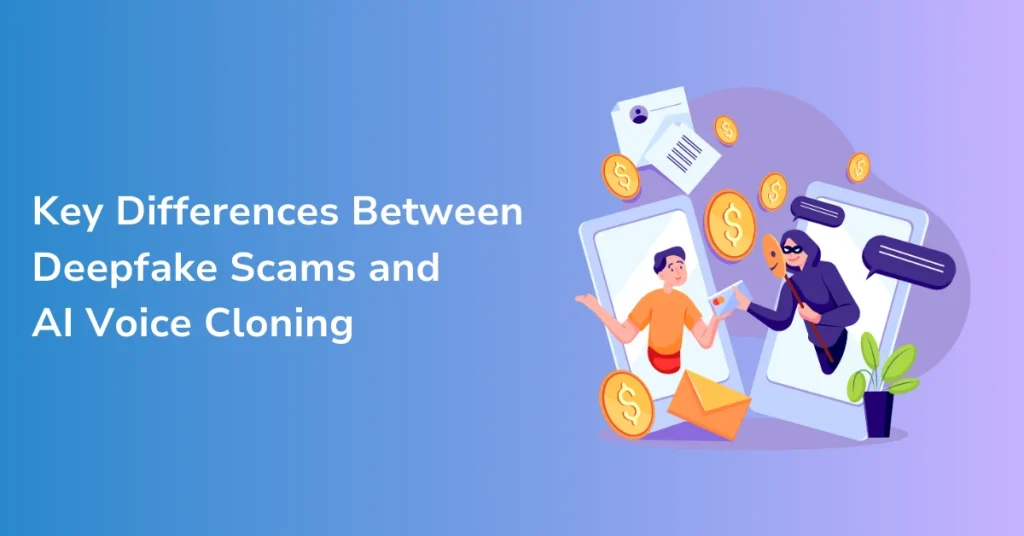You know that gut-wrenching feeling when you realize you’ve been tricked? Now imagine that trick coming from a voice that sounds exactly like your sibling… or a video call where your “boss” asks you to wire money. Chilling, right?
This isn’t a scene from Black Mirror. It’s real, and it’s exploding faster than most people realize. In 2024, hackers in the US managed to scam a major finance employee by cloning his executive’s voice in just 30 seconds, 30 seconds of audio was all it took. And over in India, police reported dozens of cases where scammers faked celebrity voices to push investment frauds. Sounds unbelievable, but it’s happening every day.
The unnerving part is we used to think scams came in clumsy forms with typos in an email, or a sketchy link promising lottery winnings. But AI has ripped the old playbook apart. Deepfake technology can now stitch someone’s face into a video, while voice cloning can replicate tone, accent, even tiny breathing pauses. Together, they create scams that feel disturbingly real.
And here’s where it gets tricky. People often lump deepfakes and AI voice cloning into one bucket. But they’re not the same. Deepfakes target your eyes. Voice cloning targets your ears. Different weapons but same battlefield. And when cybercriminals combine them? The results are terrifying.
What Are Deepfake Scams?
Deepfakes aren’t just funny internet memes of celebrities dancing on TikTok anymore. They’ve crossed into something far darker like scams that can empty bank accounts, ruin reputations, and shatter trust in seconds.
So, what exactly is a deepfake scam? It’s when criminals use AI to manipulate videos or images, making someone appear to say or do things they never actually did. Picture this scenario, a video of your company’s CFO “authorizing” a transfer of funds, or a politician “admitting” to crimes on camera. Totally fake, yet frighteningly convincing.
The creepy part is these scams are already in play. In 2024, a multinational firm in Hong Kong lost over $25 million after employees joined a video call with what looked like their senior executives. Every face on that call? A deepfake. Every word? Generated. Yet the staff followed instructions because who would doubt their boss’s face staring right at them?
And it’s not just big corporations. Everyday people are getting hit too. Scammers have created deepfake videos of influencers to push bogus crypto schemes. Some victims even reported receiving fake ransom clips showing loved ones “kidnapped” , all stitched together with AI tools.
Sounds terrifying, right? Because it is. Deepfake scams don’t just steal money, they steal something more valuable and that is trust. The trust that what you’re watching is real. The trust that your boss, your friend, or your partner on a video call is actually them. Once that cracks, everything feels suspicious.
What is AI Voice Cloning?
Think of the one voice you know better than anyone else’s. Maybe it’s your parent calling you to dinner. Or your best friend laughing at your bad jokes. You’d swear you could never mistake it.
Well, AI just proved us wrong. AI voice cloning is the chilling ability to recreate someone’s voice so precisely that it feels like they’re standing right next to you. All it takes is a short audio clip, sometimes just 10 to 20 seconds and advanced algorithms can copy the pitch, rhythm, accent, even tiny quirks like a cough or sigh.
The unnerving part is that scammers are already using it. In 2023, a family in Arizona received a panicked call from what sounded like their daughter saying she’d been kidnapped. They later learned the girl was safe and the “voice” was AI-generated. And just this year, reports across Europe showed fraudsters cloning executives’ voices to order fake transfers, draining accounts in minutes.
But the twist is it’s not just about money. Criminals use voice cloning for emotional manipulation too. Imagine getting a late-night call from a loved one asking for help, would you pause to question it, or rush into action? That’s what makes this scam so terrifying. It doesn’t just target your wallet. It hijacks your trust and your instincts.
Unlike deepfakes, which manipulates your eyes, voice cloning goes straight for your ears. No flashy visuals. No suspicious links. Just a familiar, trusted voice that isn’t real.
Key Differences Between Deepfake Scams and AI Voice Cloning

1. The Sense They Target
Deepfake scams trick your eyes. They manipulate videos or images so you “see” something that looks real, even when it isn’t. Voice cloning, on the other hand, attacks your ears. It recreates a voice so flawlessly that you believe the person on the other end is genuine. Both senses are powerful, but when combined? The result is devastating because our brains are wired to trust what we see and hear.
2. Complexity of Creation
Deepfakes often require more data for multiple images, videos, or reference angles to craft a convincing fake. That’s why politicians and celebrities are usually the first targets; their faces are plastered everywhere online. Voice cloning, by contrast, needs shockingly little. In some cases, just a 15-second clip ripped from a YouTube video or a voicemail is enough. This is efficiently creepy.
3. Scale of Impact
Deepfakes tend to hit the masses. A fake video of a CEO or influencer can go viral and trick thousands at once, spreading misinformation or scams at lightning speed. Voice cloning, though, is usually personalized. It’s designed for one-on-one manipulation like a fake call to an employee, or a parent panicked into sending money. One feels like propaganda; the other feels like a con job whispered directly into your ear.
4. Emotional Trigger
Deepfake scams usually play on visual authority. You see your “boss” on a video call or a famous figure endorsing an investment, it looks real and so you act positively. Voice cloning is more intimate. It hijacks emotional bonds. A loved one crying, a friend begging for help and it feels too personal to doubt. That intimacy makes voice cloning especially unnerving, because it doesn’t just fool you, it manipulates your heart.
5. Detection Difficulty
Spotting a deepfake video is hard, but not impossible. Sometimes lip movements feel off, or lighting doesn’t quite match. With voice cloning, though? Forget it. Over a phone call, there are no visual cues, just sound. And when panic or urgency is layered in, people rarely stop to analyze whether the voice feels “too perfect.” That’s why experts say voice cloning scams are even scarier in the short term.
| Aspects | Deepfake Scams | AI Voice Cloning |
| Sense Targeted | Tricks the eyes through manipulated visuals. | Tricks the ears by replicating voices. |
| Data Requirement | Needs multiple images or videos to build realism. | Requires very little audio, sometimes just seconds. |
| Scale of Impact | Often aimed at large audiences or public influence | Usually focused on one-on-one, personal manipulation. |
| Emotional Trigger | Relies on visual authority and credibility. | Relies on intimate, emotional trust in a familiar voice. |
| Detection Difficulty | Can sometimes be spotted through visual flaws. | Extremely hard to detect without advanced tools. |
Risks of Deepfake Scams and AI Voice Cloning
The real danger with these scams isn’t just money, it’s trust. Once people can’t believe what they see or hear, the whole foundation of communication starts to crack. Here’s how the risks play out:
1. Financial Losses
Both deepfake scams and voice cloning have proven to be expensive nightmares. Fraudsters use them to authorize fake transfers, push investment schemes, or demand ransom payments. Whether it’s a fake video or a cloned voice, the endgame is the same: your money, gone.
2. Emotional Manipulation
Voice cloning especially hits hard here. Hearing a loved one beg for help can make even the most rational person act without thinking. Deepfakes also trigger emotions like fear, urgency, even excitement by showing something shocking. These scams don’t just steal money; they hijack your feelings.
3. Reputation Damage
A deepfake video of an executive saying the wrong thing, or a public figure caught in a fake scandal, can ruin reputations overnight. Once the clip spreads, good luck convincing the world it wasn’t real. Voice cloning is subtler, but it can still leave someone accused of words they never actually said.
4. Erosion of Trust
This is the most chilling risk of all. When people realize voices and faces can be faked, doubt creeps in everywhere. Every video call, every urgent phone message, every recording taht appears suddenly, it feels suspicious. That erosion of trust has long-term consequences, both for personal relationships and for businesses trying to maintain credibility.
5. Legal and Security Fallout
Companies targeted by these scams don’t just face financial damage. They can be hit with lawsuits, compliance issues, or regulatory penalties if customer data or funds are lost. For individuals, falling victim can mean police reports, frozen accounts, and months of stress trying to recover.
How to Protect Yourself from Deepfake Scams and AI Voice Cloning ?

The scary part about these scams is how real they feel. But here’s the good news, you’re not helpless. With the right mindset and a few precautions, you can stay several steps ahead.
1. Verify, Don’t Just Trust
If you get an urgent call or video request even if it looks or sounds real, take a pause. Double-check through another channel. Call the person back on their official number, send a quick email, or confirm face-to-face if possible. That extra 30 seconds could save you thousands.
2. Educate Yourself and Your Team
Most scams succeed because the victim simply doesn’t know such technology exists. Regular awareness training at work and even at home helps people recognize red flags. The moment someone hears, “AI scams are a thing now,” they become a lot harder to trick.
3. Use Multi-Factor Verification
Don’t rely on a single channel of communication. Businesses especially should set up multi-step approval processes for financial transactions. A cloned voice might slip through one check, but it won’t pass through two or three.
4. Stay Updated on Security Tools
AI detection tools are getting better. Some can spot subtle glitches in audio or unnatural artifacts in video. While they’re not perfect, they add an extra layer of defense. Even simple measures like call-back policies or watermarking video calls can help.
5. Trust Your Instincts
It sounds old-fashioned, but it works. If a voice sounds a little “off” or a video feels too smooth, listen to that gut feeling. Scammers count on panic and urgency to cloud your judgment. Slow down. Breathe. Think before you act.
Conclusion
Deepfake scams and AI voice cloning aren’t just clever tricks, they’re a direct attack on one of the most basic human instincts: trust. For decades, we’ve trusted what we see and what we hear. Now, even that certainty is being ripped away by machines that can mimic reality with chilling precision.
But here’s the truth, technology may be getting smarter, yet so can we. The key isn’t panic, it’s preparation. Knowing these scams exist, questioning the “too real” moments, and building habits of verification can make all the difference.
At the end of the day, fraudsters thrive on speed, fear, and surprise. Take those weapons away, pause, confirm, double-check and suddenly, their schemes lose their power.
Because while AI can fake a face or steal a voice, it can’t replace one thing and that’s human judgment sharpened by awareness. And that’s our strongest defense.
FAQs: Deepfake Scams vs AI Voice Cloning
1. How can I tell if a video or call is a deepfake or AI voice clone?
Answer: While detection is tricky, some warning signs include unnatural pauses, overly smooth visuals, or voices that sound “too perfect.” When in doubt, verify through another channel like call, email, or a secure messaging app.
2. Are businesses more at risk than individuals?
Answer: Both are at risk, but the targets differ. Businesses face large-scale financial or reputation damage, while individuals are often targeted for personal fraud or emotional manipulation. Awareness is key for both.
3. What preventive measures can companies take?
Answer: Companies should implement multi-step verification for sensitive actions, train employees on AI scam awareness, and use detection tools for video and audio content. Regular drills and policy updates strengthen defenses.
4. Is AI voice cloning or deepfake technology illegal?
Answer: Yes, using either for fraud, impersonation, or malicious intent is illegal in most countries. However, research and entertainment uses exist legally. The challenge is enforcement and awareness.
5. What should I do if I suspect a deepfake or AI voice scam?
Answer: Stop immediately. Do not share money or sensitive information. Report it to your organization’s security team or local authorities. Document the incident with screenshots or recordings if possible as it can help investigations.








